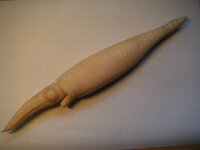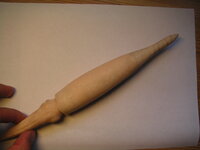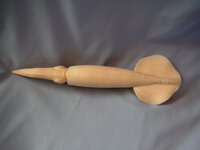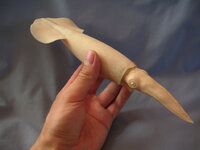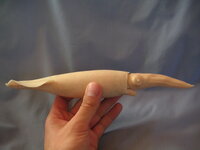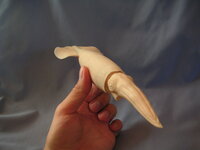Thanks Sourdes, maybe I will try Fimo then, we do get it here, although it's a bit more expensive but if it's more durable, it will be worth it!
You are using an out of date browser. It may not display this or other websites correctly.
You should upgrade or use an alternative browser.
You should upgrade or use an alternative browser.
Sculpting belemnites for a museum exhibition - your thoughts are welcome
- Thread starter Sordes
- Start date
I have finally finished the rostrum and added also some more sculpey on the mantle. It turned out to be extremely difficult to get it into the right shape, and I had to sand it for a long time on a grinder to make the surface even. It can be really much harder to sculpt a completely detail-less but even and smooth surface than sculpting a highly textured and detailed surface.
Attachments
Coming along nicely 
After a pause I finally managed to finish the bigger belemnite. I made it slightly different from the first model, with some more details. I gave it strong and big fins, as I suppose those belemnites were fast and aggressive predators, despite the fact they were common prey for many other larger predators too.
Attachments
- Joined
- Oct 19, 2003
- Messages
- 3,111
So lifelike, great work!
Very nice sculpture Sordes! 
I can't wait to see the ammonites.
I can't wait to see the ammonites.
- Joined
- Dec 20, 2009
- Messages
- 961
Cool! This will be fun to watch.
It´s actually really not that easy to get a good cast of an undamaged ammonite. The museum has probably literally tons of ammonites in its archives, but most of them are damaged to some degree, still partly within rocks, or flattened. I have now two casts, which are in comparably good condition, but there is still a lot to restore before I can start with the soft-parts. I choose one which has one side which needs very little restoration, and when it is attached to a wall, it doesn´t matter if the other - not visible side - is somewhat damaged. One problem with ammonites is that many species have highly ornamented shells. This is hard to sculpt and also hard to restore on a fossils, for this reason I searched for a specimen with a comparably even surface.
I know Kevin will be interested in seeing your rendition of the head, arms and tentacles.
It is really highly frustrating how little we actually know about ammonites, despite the fact they are among the most abundant (non-micro) fossils. There are fantastic fossils with soft tissue impressions of belemnites, but there is nothing comparable from ammonites even from the same strata. Some of the ammonites are fossilized in really perfect condition, the only thing missing are soft tissue impressions. But even this absence of structures, gives us some clues. We can for example be quite sure that ammonites had no chitinous hooks like those of belemnites, as they fossilize comparably easy. It´s also not that probably that there were any suckers with chitinous parts. So there remains suckers, cilia or a surface similar to nautilus tentacles. I am still not completely sure how I will sculpt them. I don´t really like sucker-idea, at most I could imagine tiny sucker pads as those of Spirula. Vampyroteuthis-like cilia would be also a good choice I think. There is also not the slightest indicatpion of a beak in nautiloids, even in the best preserved fossils no chitinous beak is present, despite the fact that beaks are known from many other cephalopods like belemnites, nautilus and "modern" squids. Many reconstructions show nautiloids with beaks, even my own old models, but I won´t sculpt a beak in the newer models. There are several indications that ammonites were planctivorous, or at least mainly predators of very small prey. For this reason I will give them also a big "umbrella" between its tentacles, similar to those of Vampyroteuthis. As a planctivore doesn´t need super-strong senses, I will also sculpt the eyes comparably small.
And last but not least I still don´t know what to do with this stupid Aptychus!
And last but not least I still don´t know what to do with this stupid Aptychus!
DWhatley;181530 said:I know Kevin will be interested in seeing your rendition of the head, arms and tentacles.
I was more interested in how the shell could be sculpted, not thinking of just making a mold.
Sordes;181534 said:And last but not least I still don´t know what to do with this stupid Aptychus!
Internal aptychi are invisible.
 Used as a crushing plate for plankton. I like the idea of an umbrella and small eyes.
Used as a crushing plate for plankton. I like the idea of an umbrella and small eyes.Actually the left side of the casted ammonite shell was still covered with stone (and now of course gypsum) to a big degree, and it had also some deffects. So I had to fill the deffects and carve a complete new spiral, what worked surprisingly good, my carved side looks now not much badder than the original side. I will soon post some photos. Stupidly I have no photos of the original shape.
I am not that sure that aptychi were used for grinding food, even internal ones. Why evolving an aptychus which is larger than a normal beak when prey is mainly plancton? A radula should already be able to scrunch this small animals.
I am not that sure that aptychi were used for grinding food, even internal ones. Why evolving an aptychus which is larger than a normal beak when prey is mainly plancton? A radula should already be able to scrunch this small animals.
Similar threads
- Replies
- 1
- Views
- 208
- Replies
- 0
- Views
- 704

